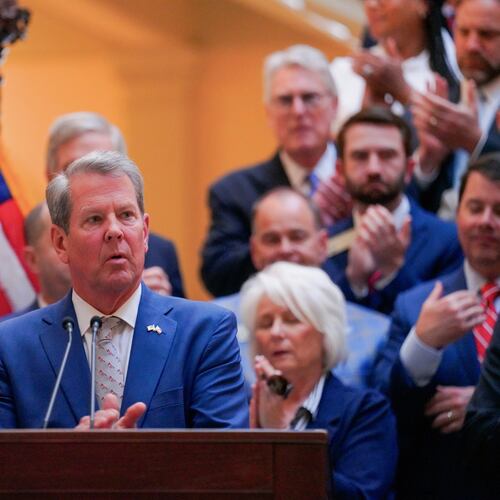In late September, the state began making one-time payments of $350 to Georgia residents in need.
Despite a bumpy rollout, AJC health and safety reporter Katherine Landergan noted that more than 800,000 people have claimed the money to spend on necessities such as groceries, utility bills and other retail items.
The $1.2 billion to fund those one-time payments to as many as three million residents came from President Biden’s COVID-19 relief package, approved by Congress on a party line vote in March 2021. Gov. Brian Kemp and other Republicans have publicly opposed the program.
Kemp announced in August that he would use part of the relief funds to benefit Georgia residents enrolled in Medicaid, the Supplemental Nutrition Assistance Program (SNAP) and Temporary Assistance for Needy Families (TANF).
“This assistance will help some of Georgia’s most vulnerable citizens cope with the continued negative economic impact of the COVID-19 public health emergency and 40-year-high inflation caused by disastrous policies that were implemented by the Biden administration,” said Kemp’s office in a statement.
Critics have said Kemp’s one-time payments to needy Georgians is nothing more than a pre-election ploy. “He wants to spend like a drunken sailor to help his reelection at the same time he’s throwing bombs at Democrats in Washington who provided the money,” said State Sen. Nan Orrock (D-Atlanta) in an August interview with the AJC.
State law allows the governor to decide how federal money is spent and Kemp has been on a spending spree, allocating millions to expand high speed internet in rural Georgia, provide law enforcement bonuses, award grants to businesses and nonprofits, and fund water and sewer improvements rather than expand access to programs that help impoverished families.
Food stamp benefits were reduced in May when Kemp ended the COVID-19 state of emergency. Rental assistance distributions have lagged under Kemp’s administration, and the state has only partially expanded Medicaid.
While Kemp is now handing out cash payments to the poor, the cash assistance program that residents routinely rely on has not kept pace with inflation. In 1991, a family of three received $280 in TANF benefits. In 2022, the TANF grant for a family of three is still $280, according to data from the Georgia Budget and Policy Institute. The very nature of TANF, a block grant, encourages states to keep enrollment low so that surplus funds can be used for other budget items.
During the pandemic, enrollment in TANF continued to decline. In July 2019, TANF benefits were granted to 9,165 Georgia households, according to data from the Division of Family and Children Services. By June 2020, enrollment was down to 8,346.
TANF may have tanked during the pandemic but other forms of cash assistance, including unemployment benefits (which must be exhausted in order to qualify for TANF) and stimulus payments for low- and middle-income families, proved to be an effective safety net.
Part of the stimulus package also included a fully refundable Child Tax Credit (CTC) that enabled the poorest families, who previously were not eligible, to receive the benefit. Another hallmark of the temporary CTC, which also raised the maximum credit, was to allow advance credit payments (up to half) to be dispersed monthly rather than as one lump sum at tax time.
When the CTC payments stopped in Dec. 2021, 60% of parents who had previously received the monthly aid said it was difficult for their family to meet expenses. That includes basic expenses such as food, paying bills, clothing and housing, according to a September brief from the Center for Law and Social Policy.
Child poverty rose 41% when the CTC expired in January, according to research from the Center on Poverty and Social Policy at Columbia University.
In a recent New York Times essay, former secretaries of treasury Robert E. Rubin and Jacob J. Lew outlined how the CTC could be made permanent without increasing inflation. Keeping the current $2,000 credit refundable would help families with no or low incomes, reducing child poverty by about 20%, they wrote.
A permanent CTC could be transformative to the many families with children who are now receiving those one-time payouts from Kemp.
But with no action at the federal level to make the CTC permanent, some states are adopting and expanding their own child tax credits. Georgia isn’t one of those states.
One-time payments are a temporary remedy to help families in need, but policy experts know those payments won’t do much to combat poverty in the long term.
Read more on the Real Life blog (www.ajc.com/opinion/real-life-blog/) and find Nedra on Facebook (www.facebook.com/AJCRealLifeColumn) and Twitter (@nrhoneajc) or email her at nedra.rhone@ajc.com.
About the Author
Keep Reading
The Latest
Featured



